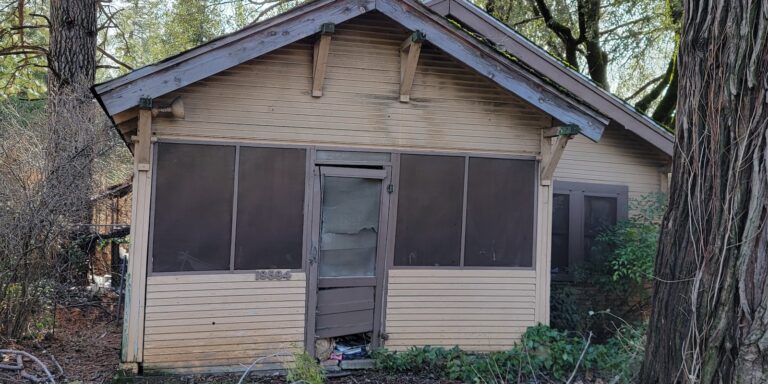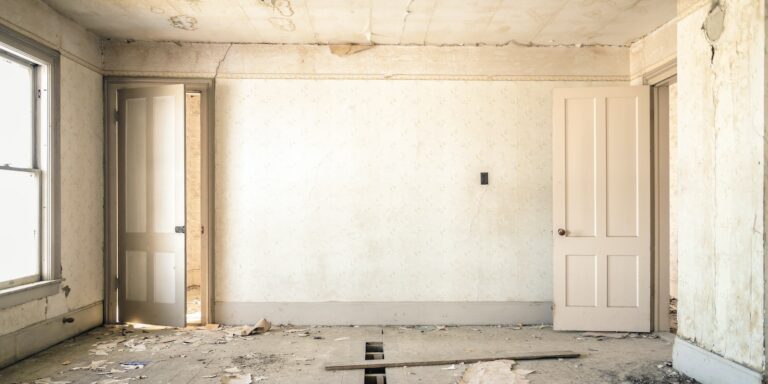The Step-by-Step Guide to Fix and Flip Real Estate Investing
The Ultimate Fix and Flip Real Estate Investing Strategy is a unique Strategy that helps real estate investors complete more fix and flip deals without having to spend a lot of time looking for properties, renovating the properties, or marketing to sell the properties. The following is a step-by-step guide to fix and flip real estate investing and are the recommended steps you should follow:
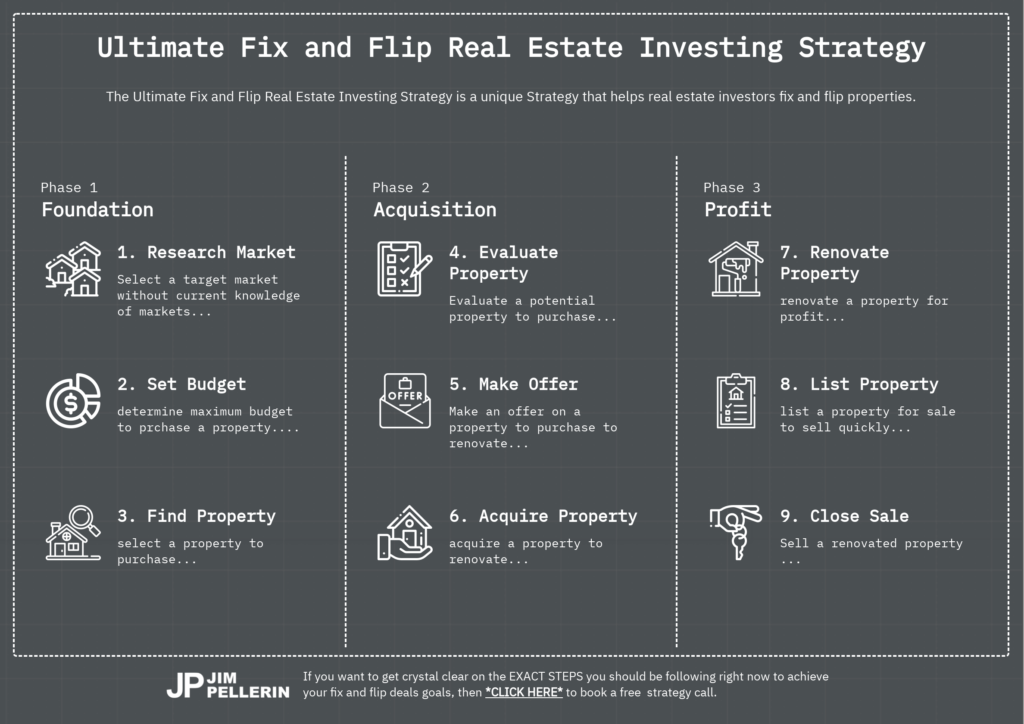
Foundation
- Research Market: Research various markets to locate an area where you are likely to find the best properties that provide the best returns for you.
- Set Budget: Flipping a property requires a significant amount of capital, so it’s important to set a budget before you start looking for properties.
- Find Property: Identify potential properties that fit your criteria. Assess the property’s condition and potential for flipping. Consider financing options and calculate the renovation costs.
Acquisition
- Evaluate Property: Next, you will inspect the property for any structural issues, water damage, or other costly repairs that may need to be made. You should also take note of any cosmetic changes that need to be made, such as updating the kitchen or bathrooms.
- Make Offer: Once you’ve evaluated the property and determined that it’s a good investment, it’s time to make an offer. Be sure to take into account any repairs or renovations that need to be made when determining your offer price..
- Acquire Property: Once you’ve made an offer and the purchase and sale agreement is accepted, the next step is to secure financing and acquire the property.
Profit
- Renovate Property: Now, it’s time to renovate. Work with contractors and designers to create a renovation plan that will increase the value of the property.
- List Property: Once the renovations are complete, it’s time to list it for sale. work with a real estate agent to market the property and find a buyer.
- Close Sale: Once you’ve found a buyer, it’s time to close the sale. This means finalizing all the paperwork and transferring ownership of the property to the new owner.
Foundation
1. Research Market

Before you invest in any real estate property, it’s important to do your research. This means taking a deep dive into the real estate market in the area where you want to invest. Look for trends in property values, rental rates, and housing demand. You should also research the types of properties that are popular in the area, such as single-family homes, condos, or multi-unit buildings. This research will help you identify the types of properties that are likely to provide the best returns.
Steps
1. Identify the real estate market you want to invest in: Begin by researching and narrowing down your focus to a particular area. Consider factors such as location, employment opportunities, population growth, and real estate market trends.
2. Look for trends in property values, rental rates, and housing demand: Use reliable sources such as online listing sites, real estate agents, or local classified sites to obtain data on property values, rental rates, and housing demand. Look for patterns and trends in the data to help you make informed decisions.
3. Research the types of properties that are popular in the area: Determine what types of properties are in high demand in the area. For instance, single-family homes may be more popular in some areas, while multi-unit buildings may be in higher demand in others. Look for trends in property type and consider what type of property is likely to provide the best returns.
Challenges
1. Lack of knowledge about real estate markets in different locations: Investing in real estate in a new location can be challenging if you don’t have a good understanding of the local market. Consider working with a local real estate agent who can provide insight into the market and help you make informed decisions.
2. Difficulty in identifying reliable sources of data for property values, rental rates, and housing demand: Finding accurate and reliable data on real estate markets can be challenging. Look for reputable sources of data, such as online websites or real estate agents, and be cautious of sources that may provide biased or incomplete information.
3. Understanding the nuances of different property types and their demand in different locations: Different types of properties may be in higher demand in different locations. For example, multi-unit buildings may be more popular in urban areas, while single-family homes may be more popular in suburban areas. It’s important to understand these nuances to make informed investment decisions.
2. Set Budget

Flipping a property requires a significant amount of capital, so it’s important to set a budget before you start looking for properties. This means determining how much money you have available for the purchase and renovation of a property. You should also factor in all the costs associated with flipping a house, including closing costs, renovation costs, and holding costs. Setting a realistic budget will help you narrow your search and find properties that are within your price range.
Steps
1. Determine how much money you have available for the purchase and renovation of a property: To determine your available funds, start by calculating your total assets, including cash, investments, and any lines of credit you may have available. Next, subtract any outstanding debts or liabilities to get a clear picture of your liquid assets. This will give you an idea of how much money you have available for a down payment and renovation costs.
2. Factor in ALL the costs associated with flipping a house: Flipping a property involves several costs, including the purchase price of the property, closing costs, renovation costs, and holding costs. Renovation costs can vary widely depending on the condition of the property and the extent of the renovations required. Holding costs include property taxes, insurance, utilities, and any mortgage payments or interest on loans used to finance the project. Be sure to factor in all of these costs when setting your budget.
3. Decide on a maximum purchase price for the property: Based on your available funds and the total costs associated with flipping a house, you can determine the maximum purchase price for the property. This will ensure that you can afford the property and still have enough money for renovations and holding costs. Keep in mind that the purchase price should also leave enough room for a potential profit when you sell the property.
Challenges
1. Difficulty in accurately assessing your available funds and assets: One solution could be to work with a financial advisor or accountant to help you calculate your available funds and assets accurately. You could also research and compare financing options to help you determine what type of loans or lines of credit you may qualify for.
2. Underestimating the true costs of renovation, closing costs, and holding costs: To avoid underestimating costs, it’s important to research and gather quotes from contractors and service providers to get a realistic estimate of the renovation costs. It’s also important to factor in all of the holding costs, including property taxes and insurance, when setting your budget.
3. Balancing the purchase price with the expected return on investment: This can be a challenge, as you don’t want to overpay for a property and risk losing money on the project. To address this challenge, it’s important to research the real estate market in the area and compare the purchase price of the property to similar properties in the area. You could also work with a real estate agent or appraiser to help you determine the potential value of the property after renovations.
3. Find Property
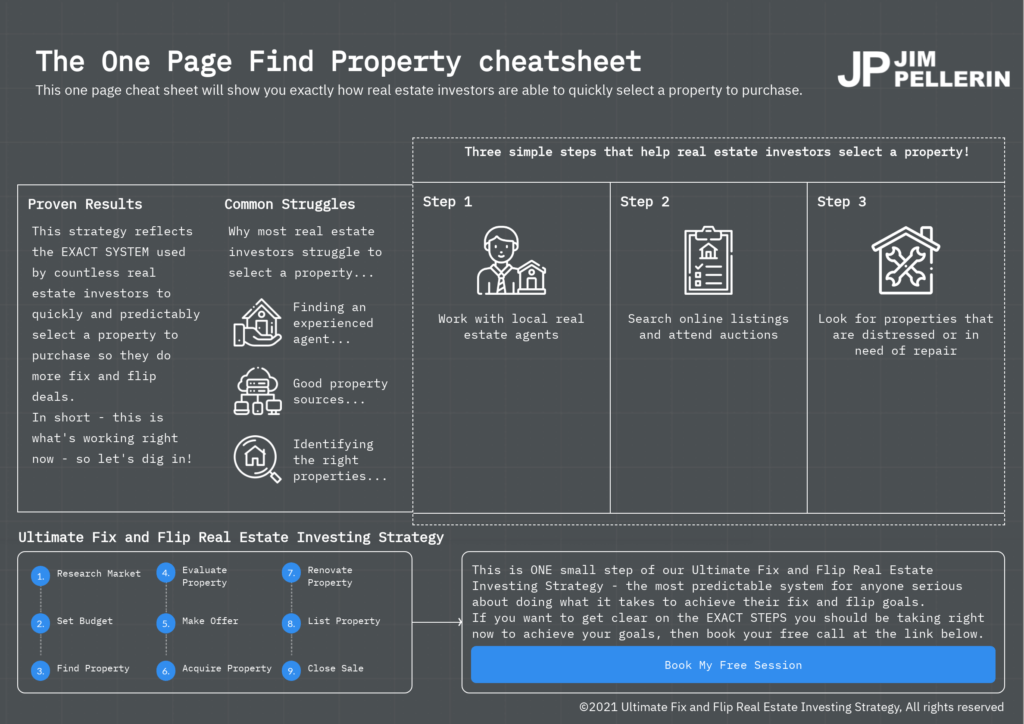
Once you have your budget set, it’s time to start looking for a property to flip. There are many ways to find properties, including working with a real estate agent, searching online listings, and attending auctions. Look for properties that are distressed or in need of repair, as these are often the best candidates for flipping.
Steps
1. Work with a real estate agent: A real estate agent can help you find properties that meet your criteria and provide you with valuable insights about the local real estate market. Look for an agent who has experience working with fix-and-flip properties and can guide you through the process of purchasing a distressed property. They can also help you negotiate with the seller and ensure that the transaction goes smoothly.
2. Search online listings and attend auctions: Online listings and auctions are great sources of properties that are in need of repair. Many websites specialize in listing distressed properties, such as foreclosures or short sales. You can also attend auctions where foreclosed properties are sold to the highest bidder.
3. Look for properties that are distressed or in need of repair: Look for properties that are in need of repair or renovation, as these are often the best candidates for flipping. These properties may have been foreclosed, abandoned, or neglected, and they can be purchased at a discount. Keep in mind that the extent of repairs needed should be proportional to the potential increase in the property’s value.
Challenges
1. Finding a real estate agent who has experience with fix-and-flip properties: It can be challenging to find a real estate agent who has experience working with fix-and-flip properties. Not all agents are familiar with the process, so it’s important to do your research and find an agent who has a proven track record of working with investors who flip properties.
2. Finding accurate and up-to-date listings online: Online listings can sometimes be outdated or inaccurate, which can be frustrating when trying to find the right property. It’s important to use reputable websites and verify the information before making any offers.
3. Identifying properties with the right balance of repair needs and potential for value increase: It can be difficult to find properties that have the right balance of repair needs and potential for value increase. Some properties may require more repairs than they are worth, while others may not have enough potential for a significant increase in value. It’s important to carefully evaluate each property and consider all the potential costs and returns before making a decision.
Acquisition
4. Evaluate Property
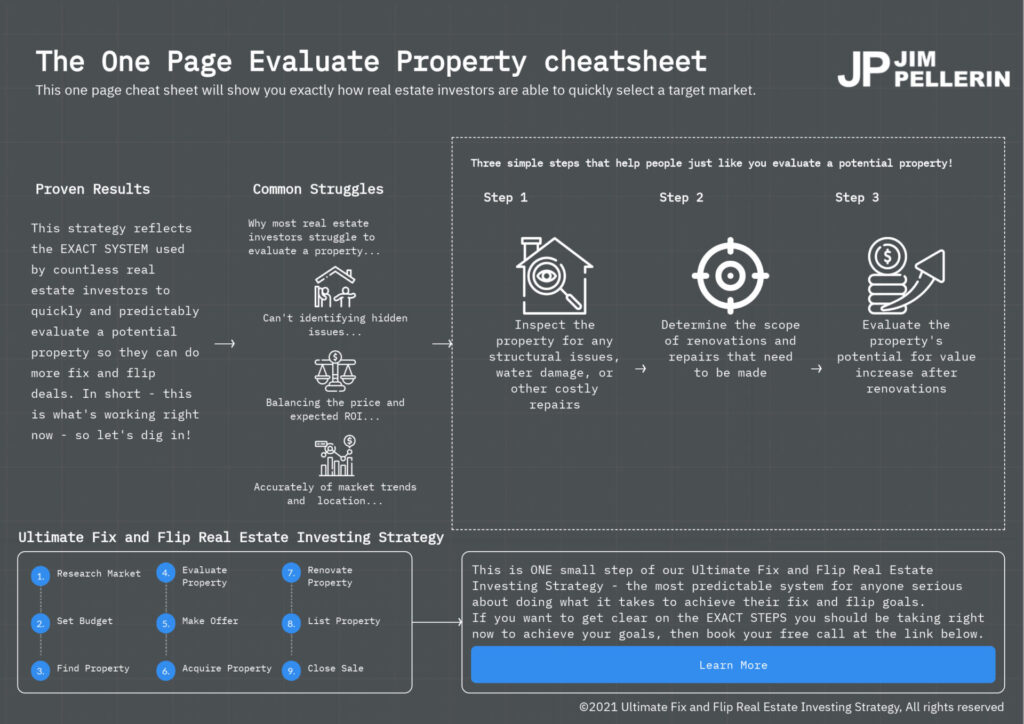
Before you make an offer on a property, it’s important to thoroughly evaluate it. This means inspecting the property for any structural issues, water damage, or other costly repairs that may need to be made. You should also take note of any cosmetic changes that need to be made, such as updating the kitchen or bathrooms.
Steps
1. Inspect the property for any structural issues, water damage, or other costly repairs: This step involves hiring a professional home inspector or contractor to conduct a thorough examination of the property. The inspector will identify any structural issues, such as foundation problems, roof leaks, or pest infestations. They will also look for water damage, mold, and other signs of moisture problems, which can lead to costly repairs if left unchecked.
2. Determine the scope of cosmetic changes that need to be made: Once the property has been inspected for any structural or water damage issues, you should evaluate the cosmetic changes that need to be made. This includes updating the kitchen, bathrooms, flooring, and other areas of the property. You should also consider whether the property needs a fresh coat of paint, new fixtures, or landscaping.
3. Evaluate the property’s potential for value increase after renovations: After identifying any repairs and cosmetic changes that need to be made, you should evaluate the potential for the property to increase in value after renovations. This involves researching the local real estate market to determine if the property is in a desirable location and if there is demand for renovated properties in the area.
Challenges
1. Identifying hidden issues that may not be apparent during an initial inspection: Sometimes, there may be hidden issues that are not visible during an initial inspection, such as plumbing or electrical problems. It’s important to hire a qualified inspector who can identify these issues and provide an accurate estimate of the cost to repair them.
2. Balancing the need for cosmetic changes with the expected return on investment: It’s important to strike a balance between making necessary cosmetic changes to the property and the expected return on investment. You don’t want to overspend on renovations that won’t add significant value to the property.
3. Accurately assessing the potential for value increase based on market trends and property location: The potential for value increase will depend on market trends and the property’s location. It’s important to research the local real estate market and consult with a real estate agent or appraiser to accurately assess the property’s potential for value increase.
5. Make Offer

Once you’ve evaluated the property and determined that it’s a good investment, it’s time to make an offer. Be sure to take into account any repairs or renovations that need to be made when determining your offer price. You should also work with your real estate agent to negotiate favorable terms, such as a shorter closing period or a lower purchase price.
Steps
1. Determine your offer price based on the property’s condition and potential for value increase: Your offer should be based on the current condition of the property and the estimated costs of repairs and renovations. You should also factor in the potential resale value after the renovations are complete. It’s important to make an offer that is competitive but still allows for a profitable return on investment.
2. Work with your real estate agent to negotiate favorable terms: Your real estate agent can help you negotiate favorable terms, such as a shorter closing period or a lower purchase price. They can also help you navigate any counteroffers from the seller or their agent.
3. Be prepared to walk away if the terms are not favorable: If the seller is not willing to negotiate or the terms of the deal are not favorable, be prepared to walk away. It’s important to protect your investment and not get caught up in a deal that is not profitable.
Challenges
1. Finding the right balance between a competitive offer and a profitable investment: Making an offer that is too low may not be accepted by the seller, while an offer that is too high can result in a lower return on investment. It’s important to find the right balance between a competitive offer and a profitable investment.
2. Negotiating with the seller or their agent who may have different priorities: The seller or their agent may have different priorities than you, such as a quick sale or a higher purchase price. It’s important to communicate your priorities and work with your real estate agent to negotiate favorable terms.
3. Balancing the desire to close the deal with the need to protect your investment: It’s important to remember that flipping a house is a business investment, and not to get too emotionally invested in a deal. You should be willing to walk away if the terms of the deal are not favorable to protect your investment.
6. Acquire Property
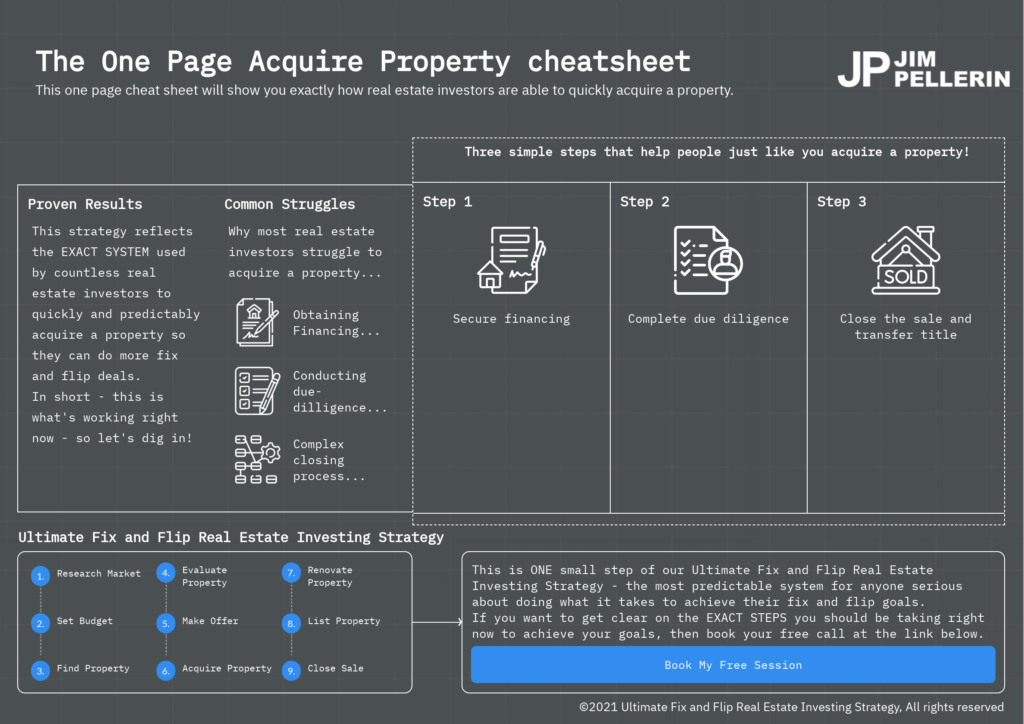
Once you’ve made an offer and the purchase and sale agreement is accepted, the next step is to secure financing and acquire the property. For financing, you should consider options such as a conventional mortgage, FHA loan, or hard money loan. You should also ensure that you have a solid understanding of the terms and conditions of the loan.
Once the financing is obtained and a property inspection is completed, the final step is to close the deal which includes the transfer of funds and the transfer of title.
Steps
- Secure financing: After the purchase and sale agreement is accepted, you need to secure financing for the property. You can either pay for the property in cash or obtain a mortgage from a lender. To obtain a mortgage, you will need to provide financial information and undergo a credit check. You may also need to provide a down payment for the property.
- Complete due diligence: Before closing on the property, it’s important to complete your due diligence. This may include a property inspection, title search, and review of any existing leases or rental agreements. This will help ensure that there are no hidden issues or liabilities with the property.
- Close the sale: Once you have secured financing and completed your due diligence, you can proceed with closing the sale. This involves signing the necessary documents and paying any remaining fees or expenses associated with the purchase.
Challenges
- Difficulty obtaining Financing: Obtaining financing can be a challenge, especially if you have a limited credit history or low income. You may need to shop around for lenders or consider alternative financing options such as private loans.
- Time for due diligence: Completing due diligence can be time-consuming and expensive. It’s important to be thorough, but this can also delay the acquisition process.
- Complex Closing Process: Closing on a property can be a complex process involving multiple parties and legal documents. It’s important to have a good understanding of the process and work with experienced professionals to ensure a smooth closing.
Profit
7. Renovate Property
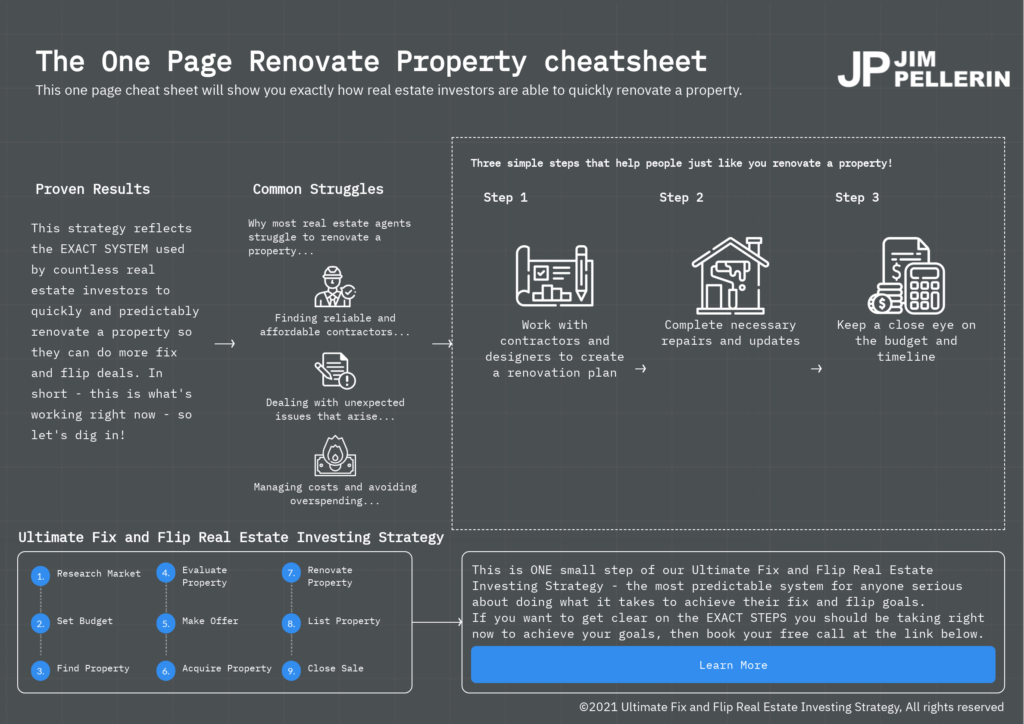
Once you’ve secured financing and closed on the property, it’s time to start renovating. Work with contractors and designers to create a renovation plan that will increase the value of the property. This may include updating the kitchen and bathrooms, replacing flooring, and painting the interior and exterior of the property.
Steps
1. Work with contractors and designers to create a renovation plan: Meet with contractors and designers to discuss the scope of the renovation and create a plan that maximizes the value of the property within your budget.
2. Complete necessary repairs and updates: Ensure that all necessary repairs and updates are completed, including fixing structural issues, updating electrical and plumbing systems, replacing damaged or outdated materials, and improving energy efficiency.
3. Keep a close eye on the budget and timeline: Stay on top of the renovation budget and timeline by regularly checking in with contractors, monitoring expenses, and adjusting the plan as needed.
Challenges
1. Finding reliable and affordable contractors and designers: Finding contractors and designers who are reliable, affordable, and have experience working on flipping projects can be a challenge. It’s important to do your research, ask for references, and carefully vet potential contractors before hiring them.
2. Dealing with unexpected issues that arise during renovation: It’s common for unexpected issues to arise during the renovation process, such as discovering hidden damage or uncovering structural problems. This can cause delays and add to the cost of the project.
3. Managing costs and avoiding overspending on renovations: It’s important to stick to the renovation budget and avoid overspending on unnecessary upgrades or materials. This requires careful planning and monitoring of expenses throughout the renovation process.
8. List Property
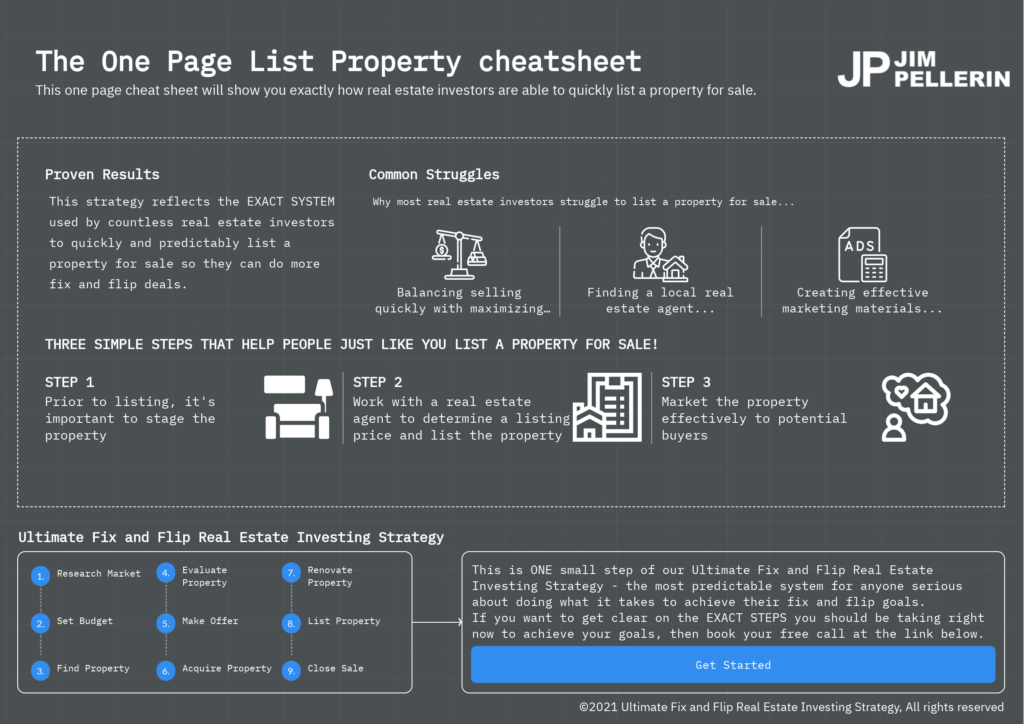
Once the renovations are complete, it’s time to list it for sale. work with a real estate agent to market the property and find potential buyers. Your agent will help you set a competitive price for the property and create a marketing plan that will reach the right audience.
Steps
1. Prior to listing, it’s important to stage the property: Staging involves decorating the property to make it more attractive to potential buyers. This may include adding furniture, artwork, and accessories to create a welcoming and inviting space. You may hire a professional stager to help with this process.
2. Work with a real estate agent to determine a listing price and list the property on multiple platforms: Your agent will help you set a competitive price for the property based on the current market conditions and the renovations you’ve made. They will also list the property on multiple platforms and other real estate websites to reach a wider audience.
3. Market the property effectively to potential buyers: Your agent will create effective marketing materials that highlight the property’s features and potential. This may include professional photos and videos, virtual tours, open houses, and other marketing techniques to attract potential buyers.
Challenges
1. Balancing the desire to sell quickly with the need to maximize profit: It’s important to find a balance between selling quickly and getting the best possible price for your property. Your real estate agent can help you make informed decisions about pricing and marketing strategies.
2. Finding a real estate agent who understands the local market and can effectively market the property: It’s crucial to work with an experienced real estate agent who understands the local market and can help you navigate the selling process.
3. Creating effective marketing materials that highlight the property’s features and potential: Creating effective marketing materials requires skill and experience. Your real estate agent should have a strong marketing plan in place to attract potential buyers and generate interest in your property.
9. Close Sale

Once you’ve found a buyer, it’s time to close the sale. This means finalizing all the paperwork and transferring ownership of the property to the new owner. Work with your real estate agent and lawyer to ensure a smooth and successful closing.
Steps
1. Review and negotiate offers from potential buyers: Once you receive offers from potential buyers, you should review them carefully and consider factors such as the purchase price, terms and contingencies. You may need to negotiate with the buyer to arrive at a mutually acceptable agreement.
2. Hire a real estate attorney to review and finalize the closing documents: A real estate attorney can review the purchase agreement and other closing documents to ensure that everything is in order and there are no legal issues that could cause problems later on.
3. Work with the buyer to schedule the closing date and transfer ownership: The closing date is the date when ownership of the property is officially transferred to the buyer. You will need to work with the buyer, their agent, and your attorney to ensure that all the necessary paperwork is completed, funds are transferred, and the property is officially transferred to the new owner.
Challenges
1. Negotiating with potential buyers who may have different priorities: Buyers may have different priorities when it comes to the purchase of a property, such as the purchase price, closing date, and contingencies. Negotiating with buyers to arrive at a mutually acceptable agreement can be a challenge, especially if there are multiple offers on the table.
2. Finding a reputable and experienced real estate attorney to review the closing documents: Hiring the right attorney is crucial to ensuring a smooth and successful closing. However, finding a reputable and experienced attorney can be challenging, especially if you are unfamiliar with flipping real estate.
3. Managing the logistics of the closing process, including scheduling and coordinating with the buyer: Closing a sale can be a complex and time-consuming process that involves coordinating with multiple parties, including the buyer, their agent, your attorney, and any lenders involved. Managing the logistics of the closing process can be a challenge, especially if there are unexpected issues that arise.
Disclosure: I may receive affiliate compensation for some of the links at no cost to you if you decide to purchase a paid plan. This site is not intending to provide financial advice. This is for entertainment and information only.
Check out the eBook or Paperbook versions











